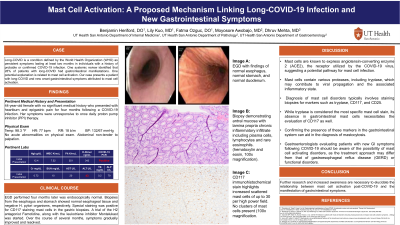Tuesday Poster Session
Category: Stomach
P4218 - Mast Cell Activation: A Proposed Mechanism Linking Long-COVID-19 Infection and New Gastrointestinal Symptoms
Tuesday, October 24, 2023
10:30 AM - 4:00 PM PT
Location: Exhibit Hall

Has Audio

Benjamin Heriford, DO
UT Health San Antonio
San Antonio, TX
Presenting Author(s)
Benjamin Heriford, DO1, Lily Kuo, MD2, Fatma Ozguc, DO3, Dhruv Mehta, MD1
1UT Health San Antonio, San Antonio, TX; 2University of Texas Health Science Center San Antonio, San Antonio, TX; 3UTHSCSA, San Antonio, TX
Introduction: Long-COVID is a condition defined by the World Health Organization (WHO) as persistent symptoms lasting at least two months in individuals with a history of probable or confirmed COVID-19 infection. One systemic review and meta-analysis performed by Choudhury et al. identified that 28% of patients with long-COVID had gastrointestinal manifestations. While the exact mechanism of long-COVID remains unclear, one potential explanation is related to mast cell activation. Our case presents a patient with long-COVID and new onset gastrointestinal symptoms attributed to mast cell activation.
Case Description/Methods: Here we present a case study of a 44-year-old female with no significant medical history who presented with heartburn and epigastric pain for four months following a COVID-19 infection. Esophagogastroduodenoscopy (EGD) was performed to evaluate her symptoms, revealing normal findings in the esophagus, stomach, and duodenum. Biopsies taken from the esophagus and stomach showed normal esophageal tissue and chronic inactive gastritis without Helicobacter pylori organisms respectively. However, special staining for CD117 demonstrated the presence of scattered CD117 positive mast cells (up to 30 per high-power field) in the gastric biopsies. The patient's omeprazole was discontinued, and she was initiated on a trial of the H2 antagonist Famotidine, along with the leukotriene inhibitor, Montelukast. Over several months, her symptoms gradually improved and eventually resolved with this treatment regimen.
Discussion: Mast cells are known to express angiotensin-converting enzyme 2 (ACE2), the receptor utilized by the COVID-19 virus, suggesting a potential pathway for mast cell infection. Moreover, mast cells contain various proteases, including tryptase, which may contribute to viral propagation and the associated inflammatory state. Diagnosis of mast cell disorders typically involves staining biopsies for markers such as tryptase, CD117, and CD25. Confirming the presence of these markers in the gastrointestinal system can aid in the diagnosis of macrocytosis. Gastroenterologists evaluating patients with new GI symptoms following COVID-19 should be aware of the possibility of mast cell activating disorders, as the treatment approach may differ from that of gastroesophageal reflux disease (GERD) or functional disorders. Further research and increased awareness are necessary to elucidate the relationship between mast cell activation post-COVID-19 and the manifestation of gastrointestinal symptoms.
Disclosures:
Benjamin Heriford, DO1, Lily Kuo, MD2, Fatma Ozguc, DO3, Dhruv Mehta, MD1. P4218 - Mast Cell Activation: A Proposed Mechanism Linking Long-COVID-19 Infection and New Gastrointestinal Symptoms, ACG 2023 Annual Scientific Meeting Abstracts. Vancouver, BC, Canada: American College of Gastroenterology.
1UT Health San Antonio, San Antonio, TX; 2University of Texas Health Science Center San Antonio, San Antonio, TX; 3UTHSCSA, San Antonio, TX
Introduction: Long-COVID is a condition defined by the World Health Organization (WHO) as persistent symptoms lasting at least two months in individuals with a history of probable or confirmed COVID-19 infection. One systemic review and meta-analysis performed by Choudhury et al. identified that 28% of patients with long-COVID had gastrointestinal manifestations. While the exact mechanism of long-COVID remains unclear, one potential explanation is related to mast cell activation. Our case presents a patient with long-COVID and new onset gastrointestinal symptoms attributed to mast cell activation.
Case Description/Methods: Here we present a case study of a 44-year-old female with no significant medical history who presented with heartburn and epigastric pain for four months following a COVID-19 infection. Esophagogastroduodenoscopy (EGD) was performed to evaluate her symptoms, revealing normal findings in the esophagus, stomach, and duodenum. Biopsies taken from the esophagus and stomach showed normal esophageal tissue and chronic inactive gastritis without Helicobacter pylori organisms respectively. However, special staining for CD117 demonstrated the presence of scattered CD117 positive mast cells (up to 30 per high-power field) in the gastric biopsies. The patient's omeprazole was discontinued, and she was initiated on a trial of the H2 antagonist Famotidine, along with the leukotriene inhibitor, Montelukast. Over several months, her symptoms gradually improved and eventually resolved with this treatment regimen.
Discussion: Mast cells are known to express angiotensin-converting enzyme 2 (ACE2), the receptor utilized by the COVID-19 virus, suggesting a potential pathway for mast cell infection. Moreover, mast cells contain various proteases, including tryptase, which may contribute to viral propagation and the associated inflammatory state. Diagnosis of mast cell disorders typically involves staining biopsies for markers such as tryptase, CD117, and CD25. Confirming the presence of these markers in the gastrointestinal system can aid in the diagnosis of macrocytosis. Gastroenterologists evaluating patients with new GI symptoms following COVID-19 should be aware of the possibility of mast cell activating disorders, as the treatment approach may differ from that of gastroesophageal reflux disease (GERD) or functional disorders. Further research and increased awareness are necessary to elucidate the relationship between mast cell activation post-COVID-19 and the manifestation of gastrointestinal symptoms.
Disclosures:
Benjamin Heriford indicated no relevant financial relationships.
Lily Kuo indicated no relevant financial relationships.
Fatma Ozguc indicated no relevant financial relationships.
Dhruv Mehta indicated no relevant financial relationships.
Benjamin Heriford, DO1, Lily Kuo, MD2, Fatma Ozguc, DO3, Dhruv Mehta, MD1. P4218 - Mast Cell Activation: A Proposed Mechanism Linking Long-COVID-19 Infection and New Gastrointestinal Symptoms, ACG 2023 Annual Scientific Meeting Abstracts. Vancouver, BC, Canada: American College of Gastroenterology.
